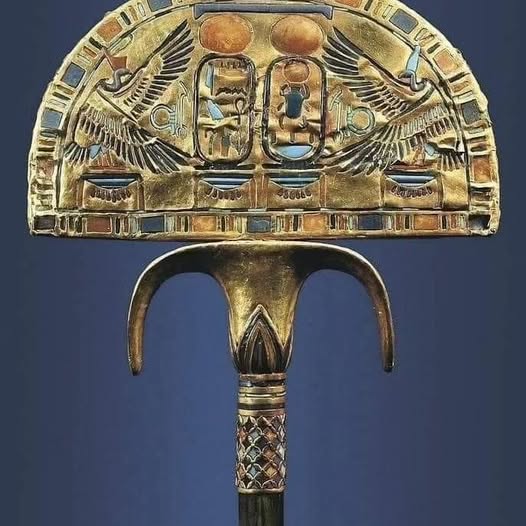
Ostrich Fan of Tutankhamun
This ceremonial fan of Tutankhamun originally held ostrich feathers, it is made of wood covered with sheets of gold and inlaid with colored glᴀss, turquoise, lapis lazuli, carnelian, and translucent calcite.
The handle is inset with gold bands at intervals. The palm of the fan is decorated with the king’s twin cartouches, which are protected by vultures wearing the White and Red Crowns of Upper and Lower Egypt, respectively.

Several signs are represented: “Was” symbolizing “dominion”; the Shen, symbolizing “eternity”; the “Nebu,” meaning “gold”; and Pet, for “sky.”
A single ostrich feather represented the Goddess Maat who was the personification of Truth, Justice and the Essential Harmony of the universe.
Ostrich feathers were often used to make fans for wealthy or important people in ancient Egypt. Fans made with ostrich feathers appear frequently in wall reliefs.
The ostrich was an animal brought to ancient Egypt from southern Africa. The ancient Egyptians used the eggs of ostriches to make small containers for perfume, and the feathers to make fans.

“The flat section is decorated with inlays of multicolored glᴀss paste with an image of the king’s cartouches in the center crowned by two sun disks and the hieroglyph that signifies the sky.
On either side of the cartouches, two deities in the form of vultures hold the emblems of power (uas) and eternity (shen) between their open wings as a sign of protection.
The birds are wearing the white crown of Upper Egypt and the red crown of Lower Egypt and rest, like the two cartouches, on the hieroglyph representing gold, the metal of the gods which, because of its quality of inalterability, was also a symbol of eternal life.”
― Daniela Comand in The Illustrated Guide to the Egyptian Museum in Cairo (#aff)

New Kingdom, late 18th Dynasty, reign of Tutankhamun, ca. 1332-1323 BC. From the Tomb of Tutankhamun (KV62), Valley of the Kings, West Thebes. Now in the Egyptian Museum, Cairo. JE 62000


